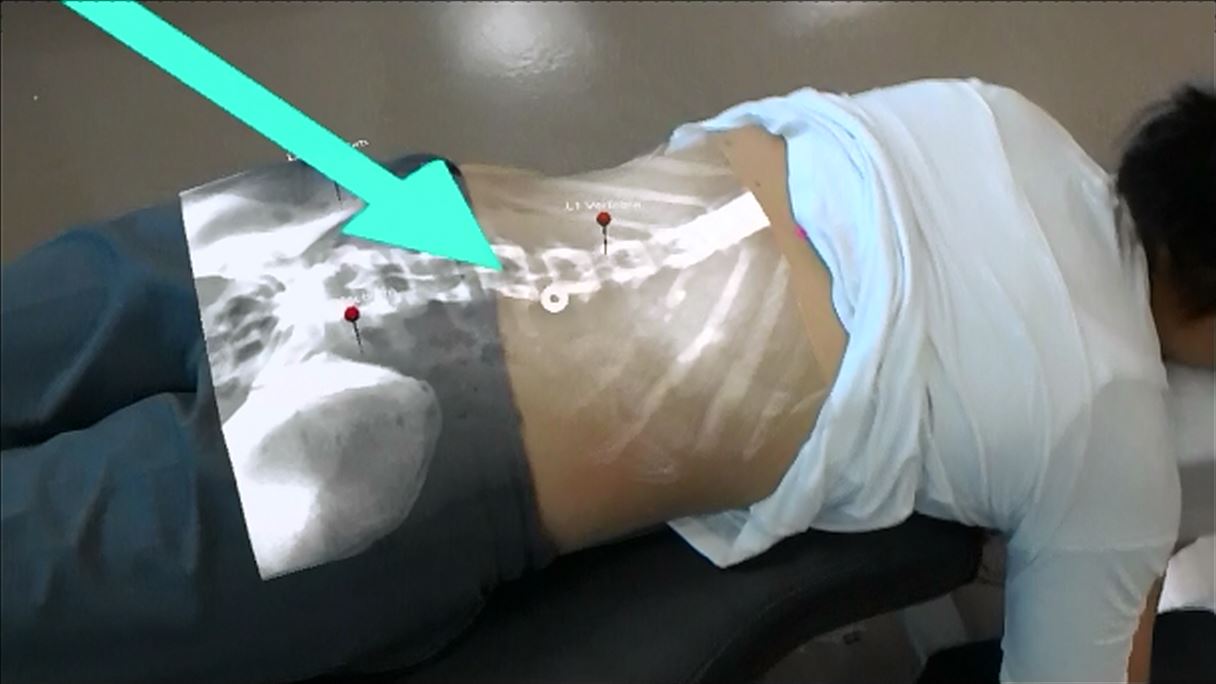
The wearable technology projects a holographic, mixed-reality superimposition of a person's X-ray on their back. (Photo: Greg Kawchuk / Rehab Robotics Lab)
Superman might be able to see through buildings, but researcher Greg Kawchuk can see through people.
A recently published University of Alberta study is looking at a new head-mounted goggle technology to reunite patients with their X-ray images.
Kawchuk, a professor in the Department of Physical Therapy, Faculty of Rehabilitation Medicine, has been working with Department of Computing Science professor Pierre Boulanger and researchers from the University of Southern Denmark to make X-ray vision a reality.
"I've been following this technology from day one. I knew right away that it could be used to help health-care professionals, such as physicians, physiotherapists and chiropractors, locate anatomy that was not apparent to normal vision. [My team and I] bought the goggles as soon as they hit the market."
While there are several different types of these goggles available, Kawchuk and his team chose to look at Microsoft Hololens for this specific study.
The wearable technology projects a holographic, mixed-reality superimposition of a person's X-ray on their back. Physicians wearing the goggles will be able to see an anatomically correct view of the person's spine, almost as though they are looking right through them. This helps with adjusting treatment and exercise plans.
"Traditionally, educators had to point to where organs were located in the body, or draw images on people's skin so they can imagine where body parts are located," said Kawchuk. "Now we don't need to do that. We can just put on a pair of goggles and 'see' what's underneath, like true X-ray vision."
Published in February in PeerJ, the study conducted by Kawchuk and his team found that the goggles were 73 per cent accurate when it came to locating vertebrae levels in the spine. A total of 13 participants who already had pre-existing spine X-rays took part in the study.
According to Kawchuk, there are positives for both the patients and the clinicians, but it really all boils down to having the ability to include the patient in their own data.
"The historic disconnect between X-ray and patient is the basis of the well-worn clinical advice to 'treat the patient, not the film.' Disconnected imaging can result in misguided interpretations of the image with respect to the patient."
While the technology will make an impact in the clinical community, there's also room for the tool to be used in an educational setting.
"This is perfect for classroom education. Not just for health-care providers and their patients, but also for students who are going to be entering into the field," said Kawchuk.
In the long run, augmented reality goggles have the potential to help both the clinician and the patient when it comes to understanding diagnosis and treatment.
"Future plans are already in the works to take the new technology into a clinical environment to see how it can improve interactions between physicians and patients when it comes to explaining imaging results. We're excited to 'see' where it goes."